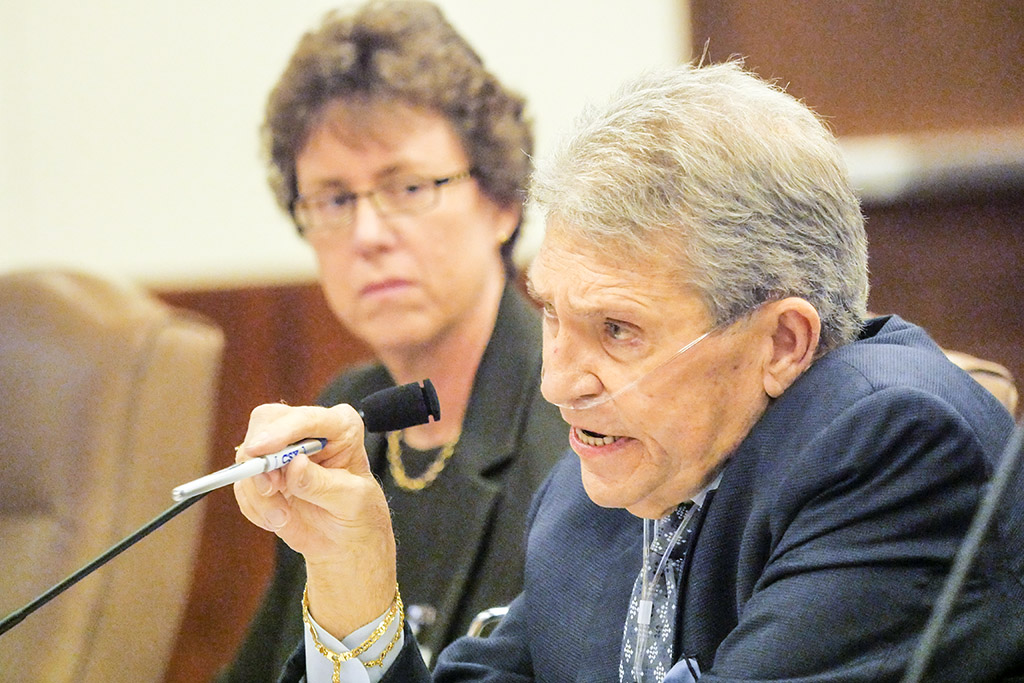But beyond the city’s limits he’s also being remembered for having challenged the late E. Hunter Harrison, who Trains magazine called the “influential and innovative railroader who was respected, sought after, feared, and loathed in equal measures.”
Weisner joined Barrington, Ill., Village President Karen Darch, as co-chairs of a coalition of suburbs who fought against the Canadian National Railway’s purchase of the Elgin, Joliet & Eastern Railroad. This coalition later helped focus regional and national attention on the potential danger posed by the shipments of crude oil and ethanol in DOT-111 tank cars.
Their efforts began in 2007 when CN announced it would pay $300 million to acquire the EJ&E, at that time a lightly used regional line that skirted the Chicago metropolitan area. It was a bold move for CN, which was then run by Harrison, whose reputation as a hard-nosed, bottom-line-focused CEO would continue to grow in later stints at Canadian Pacific and CSX Transportation.
The deal, which CN said would “fill the last gap” in its trans-Chicago network, was designed to allow its freight trains to bypass Chicago’s highly congested rail network. It took a CN train longer to get through Chicago’s freight yards than it did to travel the 700 miles from Winnipeg, Harrison said. A brilliant business decision by Harrison and CN, many thought, and CN touted the plan as its “Chicago Advantage” over its competitors.
But the acquisition would have a significant impact on dozens of towns along the EJ&E’s 198-mile line from Waukegan to Joliet to Gary, Ind. There were homeowners accustomed to seeing only a few freight trains a week now facing the prospect of scores of wall-shaking diesel behemoths passing yards from their backyards. There were dozens of grade crossings that would become blocked by mile-plus-long trains. And many worried how firefighters and ambulances would respond quickly.
Alarmed, the suburbs mobilized.
Led by Weisner and Darch, an anti-CN coalition called TRAC (The Regional Answer to Canadian National) launched a battle against Harrison and CN before railroad regulators in Washington, and in federal court. Weisner said CN was trying to “shove this project down our throat.”
“In the final analysis, the CN will enhance their profits nicely and hand the bills for all necessary improvements and infrastructure not only to taxpayers of Aurora and the other localities, but to the taxpayers of the state and the nation,” Weisner said.
Harrison, of course, was winning raves from many in the railroad industry for his cost-cutting, hard-ball management style. At a stockholders meeting in Chicago, Harrison said if the railroad’s planned expansion was blocked, Chicago’s standing as rail capital of North America would be threatened, jobs would be lost and the area’s economy would be hurt. He derided opponents for having a not-in-my-backyard attitude toward the EJ&E bypass.
“Maybe some of the citizens in the western suburbs will have to learn to deal with change,” the abrasive Harrison said.
Although TRAC raised considerably funding and gave CN a run for its money, Harrison and the railroad ultimately won Surface Transportation Board approval for the acquisition. But it wasn’t without many conditions, including years of STB monitoring. CN also cut deals with individual suburbs with EJ&E crossings. One by one, CN effectively won over many affected communities, negotiating individually and confidentially. Some suburbs reached deals for quiet zones, cameras to monitor rail crossings and other safety measures. And federal regulators required CN to pay the majority of the cost for building two rail-highway overpasses, one in Lynwood and the other in Weisner’s Aurora, two crossings where train movements would affect the most vehicle traffic.
CN fought the funding mandate in federal court, and lost that battle. Weisner called it “a substantial win,” adding that the ruling sends the message that railroads may not “walk away from the harms” they might cause.
Spurred by the 2013 fiery disaster in Lac-Mégantic, Quebec, that killed 47 people and the 2011 ethanol train derailment near Rockford, Ill., that killed one woman, Weisner and Darch led the local effort to press for improved rail tank car safety measures.
A 2015 Chicago Tribune analysis showed that more highly volatile crude oil was passing through the Midwest, specifically the Chicago area, via railroad tank cars than anywhere else in the country. Hundreds of ethanol- and crude oil-carrying tank cars are regularly transported through the Chicago region on the CN and other lines.
The TRAC coalition met with federal leaders in Chicago and in Washington, citing the hazards posed by the DOT-111 tank cars. Subsequently, the federal government authorized specifications for new tank cars and a schedule for retrofitting older cars to make them more fire-resistant. (A recent policy change by the Trump administration, however, rescinded a mandate for railroads to install electronic braking systems, as opposed to traditional air brakes, citing cost as a factor.)
Darch said she will remember Weisner as “a wonderful, selfless man who cared deeply about his family, his city, our region and the world,” adding his efforts to further transportation safety “will bear fruit for years to come.”
The man Weisner challenged, Harrison, left CN at the end of 2009, but jumped back into the industry two years later after being recruited to lead a lagging Canadian Pacific. Despite health concerns, he joined CSX in March 2017. Hailed as a “larger-than-life” figure, Harrison passed away in December of that year at age 73.















I totally agree with you Mr. Landey. Remember nothing stays the same. You may live next to a little used road or rail line, now all of a sudden things change or growth comes. Too many people what all of the modern conveniences but don’t want to put up with problems to get it there.
If you don’t want to live by a freight railroad, live somewhere else.
If you don’t want hazardous materials to be shipped by rail, then don’t consume any of the products for which the materials are used.